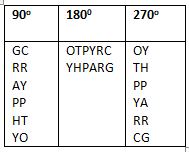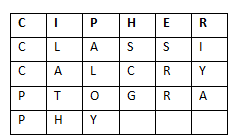At Deepwatch, " Empowering Your Digital Defense, Ensuring Your Peace of Mind"

Cryptography: It is a technique of scrambling messages using mathematical logic to keep the information secure. It preserves the scrambled message from being hacked when transported over the unsecured network. Since it converts the readable message in unreadable text.
Plaintext: It is the content of data which is in a readable form that needs to be shared over the insecure network.
Encrypting key: It is a random string of bits created particularly to scramble the plaintext information into unreadable text using mathematical logic. There are two types of encryption keys symmetric key and asymmetric key.
Ciphertext: The output of encryption produces ciphertext which is not readable by human beings.
Decrypting key: It is the key which used to decipher the ciphertext into again plaintext using the symmetric or asymmetric key to read the original message.

Functionality of cryptosystem
Classical Cryptographic Algorithms Types
Caesar cypher is a type of substitution cypher in which each letter of the alphabet is swapped by a letter a certain distance away from that letter.
Algorithm
Step 0: Mathematically, map the letters to numbers (i.e., A = 1, B = 2, and so on).

Step 1: Select an integer key K between 1 and 25 (i.e., there are a total of 26 letters in the English language) let’s say shift right to 3 alphabets where A +3 = D, B+3 = E and so on.

Step 2: The encryption formula is “Add k mod 26”; that is, the original letter L becomes (L + k)%26.
For example encryption of “IGNITE” will like as:
C = E (L+K) %26
Here L= I and K = 3
C = E (I+3) % 26
C = E (9+3) % 26
C = E (12) % 26
C = E (L)
Hence encryption of IGNITE: LJQLWH

Step 3: The deciphering is “Subtract k mod 26”; that is, the encrypted letter L becomes (L – k) %26.
For example Decryption of “LJQLWH” will like as:
C = D (L-K) %26
C = D (L-3) % 26
C = D (12-3) % 26
C = D (9) % 26
C = D (I)
Hence decryption of LJQLWH: IGNITE
Limitation: Caesar cypher is vulnerable to brute-force attack because it depends on a single key with 25 possible values if the plaintext is written in English. Consequently, by trying each option and checking which one results in a meaningful word, it is possible to find out the key. Once the key is found, the full ciphertext can be deciphered accurately.
It is also a type of substitution cipher in which each letter of the alphabet is swapped by using some permutation of the letters in an alphabet. Hence permutations of 26 letters will be 26! (Factorial of 26) and that is equal to 4×1026. This technique uses a random key for every single letter for encryption and which makes the monoalphabetic cipher secure against brute-force attack.
The sender and the receiver decide on a randomly selected permutation of the letters of the alphabet. For example in word “HACKING” replace G from “J” and N from “W” hence permutation key is 2! i.e. factorial of 2 and HACKING will become “HACKJIW”.
Algorithm
Step 0: Generate plaintext–cypher text pair by mapping each plain text letter to a different random cipher text letter IJKLQR——–GFE.

Step 1: To encipher, for each letter in the original text, replace the plain text letter with a ciphertext letter.
Hence encryption of “IGNITE” will be as shown below

Step 2: For deciphering, reverse the procedure in step 1.
Hence decryption of “USBUOQ” will be “IGNITE”
Limitations
Despite its advantages, the random key for each letter in monoalphabetic substitution has some downsides too. It is very difficult to remember the order of the letters in the key, and therefore, it takes a lot of time and effort to encipher or decipher the text manually. Monoalphabetic substitution is vulnerable to frequency analysis.
It encrypts digraphs or pairs of letters rather than single letters like the plain substitution cipher
In this cipher, a table of the alphabet is 5×5 grids is created which contain 25 letters instead of 26. One alphabet “J” (or any other) is omitted. One would first fill in the spaces in the table with the letters of the keyword (dropping any duplicate letters), then fill the remaining spaces with the rest of the letters of the alphabet in order. If the plaintext () contains J, then it is replaced by I.
Algorithm
Step 0: Split the plaintext into a pair, if the number of letters is odd then add “X” with the last letter of the plaintext
For example “TABLE” is our plaintext split it into the pair as TA BL EX
Step 1: Set the 5 × 5 matrices by filling the first positions with the key. Fill the rest of the matrix with other letters. Let’s assume “ARTI” is our key for encryption.

Step 2: For encryption, it involves three rules:
If both letters fall in the same row, substitute each with the letter to its right in a circular pattern. TA—–> IR

If both letters fall in the different row and column, form a rectangle with the two letters and take the letters on the horizontal opposite corner of the rectangle. BL—–> TN

If both letters fall in the same column, substitute each letter with the letter below it in a circular pattern. EX—–> LT

Step 3: For decryption, the receiver uses the same key to decipher the text by reversing the above three rules used in Step 2. Hence encryption of the word “TABLE” is “IR TN LT”.
Limitations:
Playfair is considerably complicated to break; it is still vulnerable to frequency analysis because, in the case of Playfair, frequency analysis will be applied on the 25*25 = 625 possible digraphs rather than the 25 possible monographs (monoalphabetic)
A polyalphabetic substitution cipher is a series of simple substitution cyphers. It is used to change each character of the plaintext with a variable length. The Vigenere cypher is a special example of the polyalphabetic cypher.
Algorithm
Step 0: Decide an encrypting key to change plaintext into cipher, for example, take “HACKING” as an encryption key whose numerical representation is “7, 0 ,2 ,10, 8, 13, 6 “

Step 1: To encrypt, the numeric number of the first letter of the key encrypts the first letter of the plaintext, the second numeric number of the second letter of the key encrypts the second letter of the plaintext, and so on.
For example, the plaintext is “VISIT TO HACKING ARTICLES” and the key is “HACKING: 7 0 2 10 8 13 6”

Step 2: The encryption formula is “Add k mod 26”; that is, the original letter L becomes (L + k)%26
C = E (L+K) %26
Here L=V and K =7
C = E (V+7) %26
C = E (21+7) %26
C = E (28) %26
C = E (2)
C = E (C)
Hence encryption of “VISIT TO HACKING ARTICLES” is “CIUSBGUOAEUQAMHRVSKYKZ”

Step 3: The deciphering is “Subtract k mod 26”; that is, the encrypted letter L becomes (L – k) %26.
For example Decryption of “CIUSBGUOAEUQAMHRVSKYKZ” will like as:
C = D (L-K) %26
Here L=C and K =7
C = E (C-7) %26
C = E (21)
C = E (V)
Hence decryption of “CIUSBGUOAEUQAMHRVSKYKZ” is “VISIT TO HACKING ARTICLES”
Limitation
The main limitation of the Vigenère cipher is the repeating character of its key. If a cryptanalyst properly estimates the length of the key, then the ciphertext can be treated as link Caesar cyphers, which can be easily broken separately.
In the rotation, cypher generates ciphertext on the behalf of block size and angle of rotation of plain text in the direction of following angles: 90o 1800 270o
Algorithm
Step 0: Decide the size of the block for plaintext “CRYPTOGRAPHY”, let assume 6 as the block size for it.
| CRYPTO |
| GRAPHY |
Step 1: For encryption arrange plaintext in any direction among these angles 90o 1800 270o as shown below:
In 90o Rotation place starting letter downwards vertically from G to C and so on.
| CRYPTO |
| GRAPHY |
In 180o Rotation place letter right to left horizontally from O to C and so on.
| CRYPTO | OTPYRC |
| GRAPHY | YHPARG |
In 270o Rotation place the last letter from top to bottom vertically from O to Y and so on.
| CRYPTO |
| GRAPHY |
Hence ciphertext will arrange in the following ways:

Step 2: arrange a letter according to their angles represents:
90o rotated cipher “GCRRAYPPHTYO”
180o rotated cipher “YHPARGOTPYRC”
270o rotated cipher “OYTHPPYARRCG”
Step 3: for decryption using block size and angle of rotation among all above three ciphertexts can be decrypted.
In transposition, cypher plaintext is rearranged without replacing the original letter from others as compared to the above cypher techniques.
Algorithm
Step 0: Decide the keyword that will represent the number of column of a table which stores plain text inside it, and help in generating cypher text, let suppose we choose CIPHER as the key.
Step 1: store plaintext “classical cryptography” in a table from left to right cell.

Step 2: for encryption arrange all letters according to columns from in ascending order of keyword “CIPHER” will be CEHIPR as:

Column 1: CCCPP
Column2: ESRR
Column 3: HSCG
Column 4: PALOY
Column 5: RIYA
Hence the cipher obtained will be “CCCPPESRRHSCGPALOYRIYA”
Step 3: for decryption, the receiver uses the key to rearrange 26 cipher letters according to their column in the 6*5 matrix.
Limitation
It was very easy to rearrange cypher letters if the correct key was guessed.
The ‘rail fence cipher’ also called a zigzag cipher is a form of transposition cipher the plain text is written downwards and diagonally on successive “rails” of an imaginary fence, then moves up when we reach the bottom rail.
Algorithm
Step 0: choose the number of rails which will act as a key for plotting the plaintext on it. Here 3 rails are decided as key for encryption
Step 1: plot plaintext “RAJ CHANDEL” on the rail in zigzag form, in direction top to bottom (downwards and diagonally) and the bottom to up (upwards and diagonally)

Step 2: for encryption place all letters horizontally starting from row 1 to row 3 as:
Row 1: RHE
Row 2: ACADL
Row 3: JN
Hence encryption for “RAJCHANDEL” is “RHEACADLJN”
Step 3: for decryption generate the matrix by multiplying the total ciphertext with the number of rails, here
A total of 10 letters are in cipher text “RHEACADELJN” and 3 rails, hence matrix will of 10*3.

Transverse the above rule used in encryption and place the ciphertext as
Row 1: RHE

Row 2: ACADL

Row 3: JN

Limitations
The rail fence cypher is not very strong; the number of practical keys (the number of rails) is small enough that a cryptanalyst can try them all by hand.
Copyright @2024 Deepwatch. All Rights Reserved.